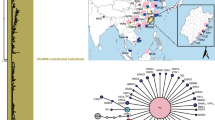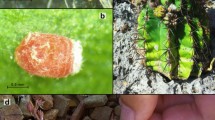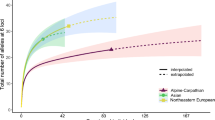Abstract
RAPID evolution of host association is now occurring independently in two populations of the host-specialist butterfly Euphydryas editha, each of which has recently incorporated a novel host species into its diet. The reasons for these episodes of rapid evolution lie in human land use practices: logging in one case and cattle ranching in the other. In contrast to other insects that have used tolerance of human activities to expand their ranges into disturbed habitats1–3, these rare butterflies have remained at their original sites and evolved adaptations to the changes occurring at those sites. At both sites, the proportion of insects preferring the novel host has increased, in one case clearly because of genetic changes in the insect population. This process is now starting to generate insects that refuse to accept their ancestral host, foreshadowing a new problem in conservation biology. By adapting genetically to human-induced changes in their habitat, the insects risk becoming dependent on continuation of the same practices. This is a serious risk, because human cultural evolution can be even faster than the rapid genetic adaptation that the insects can evidently achieve.
This is a preview of subscription content, access via your institution
Access options
Subscribe to this journal
Receive 51 print issues and online access
$199.00 per year
only $3.90 per issue
Buy this article
- Purchase on Springer Link
- Instant access to full article PDF
Prices may be subject to local taxes which are calculated during checkout
Similar content being viewed by others
References
Strong, D. R. Science 185, 1064–1066 (1974).
Strong, D. R., Lawton, J. H. & Southwood, T. R. E. Insects on Plants: Community Patterns and Mechanisms (Blackwell, Oxford, 1984).
Cornell, H. V. & Hawkins, B. A. Am. Nat. (in the press).
Thomas, C. D., Singer, M. C., Mallet, J. L. B., Parmesan, C. & Billington, H. L. Evolution 41, 892–901 (1987).
Singer, M. C. Symp. R. ent. Soc., Lond. 11, 81–88 (1984).
Wiklund, C. Oecologia 18, 185–197 (1975).
Jermy, T. Am. Nat. 124, 609–630 (1984).
Rausher, M. D. Evolution 38, 582–592 (1984).
Thompson, J. N. Evolution 42, 118–128 (1988).
Futuyma, D. J. & McCafferty, S. S. Evolution 44, 1885–1913 (1990).
Jaenike, J. A. Rev. ecol. Syst. 21, 243–273 (1990).
Prokopy, R. J., Diehl, S. R. & Cooley, S. S. Oecologia 76, 138–147 (1988).
Via, S. A. Rev. Ent. 35, 421–426 (1991).
Scriber, J. M., Biebink, B. L. & Snider, D. Oecologia 87, 360–368 (1991).
Bowers, M. D., Stamp, N. E. & Collinge, S. K. Ecology 73, 526–536 (1992).
Singer, M. C., Ng, D., Vasco, D. & Thomas, C. D. Am. Nat. 139, 9–20 (1992).
Grant, B. R. & Grant, P. R. Proc. R. Soc. B251, 111–117 (1993).
Ehrlich, P. R. Science 134, 108–109 (1961).
Singer, M. C., Ng, D. & Thomas, C. D. Evolution 42, 977–985 (1988).
Moore, S. D. Ecology 70, 1726–1737 (1989).
Jaenike, J. Evol. Ecol. 7, 103–108 (1993).
Thomas, C. D. & Singer, M. C. Ecology 68, 1262–1267 (1987).
Singer, M. C., Thomas, C. D., Billington, H. L. & Parmesan, C. Anim. Behav. 37, 751–759 (1989).
Singer, M. C. Evolution 37, 389–403 (1983).
Harrison, S., Murphy, D. D. & Ehrlich, P. R. Am. Nat. 132, 360–382 (1988).
Higgins, L. G. & Riley, N. D. A Field Guide to the Butterflies of Britain and Europe 4th edn (Collins, London, 1980).
Chinery, M. New Generation Guide to the Butterflies and Day-flying Moths of Britain and Europe (Collins, London, 1989).
Warren, M. S. Bull. Br. ecol. Soc. 16, 24–26 (1985).
Thomas, J. A. Symp. R. ent. Soc., Lond. 11, 333–353 (1984).
Thomas, J. A. Symp. Br. ecol. Soc. 31, 149–197 (1991).
Warren, M. S. Bull. Br. ecol. Soc. 20, 212–216 (1989).
Author information
Authors and Affiliations
Rights and permissions
About this article
Cite this article
Singer, M., Thomas, C. & Parmesan, C. Rapid human-induced evolution of insect–host associations. Nature 366, 681–683 (1993). https://doi.org/10.1038/366681a0
Received:
Accepted:
Issue Date:
DOI: https://doi.org/10.1038/366681a0
This article is cited by
-
Feeding experience on hairy vetch induces a loss of host-specific adaptation to maize and changes in the gut microbiota communities of the fall armyworm
Journal of Pest Science (2024)
-
Ecological changes with minor effect initiate evolution to delayed regime shifts
Nature Ecology & Evolution (2020)
-
Enemy-free space is important in driving the host expansion of a generalist herbivore to an inferior exotic plant in a wetland of Yangtze Estuary
Biological Invasions (2019)
-
From Africa to the Alps: risk assessment on an invasion by Cacyreus marshalli (Butler, 1898)
Journal of Insect Conservation (2019)
-
Genetics of lineage diversification and the evolution of host usage in the economically important wheat curl mite, Aceria tosichella Keifer, 1969
BMC Evolutionary Biology (2018)
Comments
By submitting a comment you agree to abide by our Terms and Community Guidelines. If you find something abusive or that does not comply with our terms or guidelines please flag it as inappropriate.



